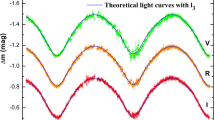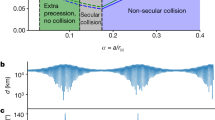Abstract
The theoretical light curves of contact binaries are calculated with and without putting in the contact binary evolution model. Firstly, we do not use the contact binary evolution model. A comparison of the light curve is performed with and without the deformation caused by rotation and tides. It shows that the light curve presents many differences, especially on the bottom and top. Secondly, we adopt the contact binary model [Huang R Q, et al. Chin J Astron Astrophys, 2007, 7: 235–244; Song H F, et al. Chin J Astron Astrophys, 2007, 7: 539–550] and compute the theoretical light curve with and without rotational and tidal effects by studying three binary systems (with low-, intermediate- and high-mass components). The bottom and top of the theoretical light curves are discussed and compared to observations. The results show that taking into account the rotational effect has a better agreement with observations than without it. Therefore, the deformation of the light curve of contact binaries caused by rotation and tides is very important. Meanwhile, the rotational and tidal effect can advance the start of the semi-detached, contact phase and the time of mass-reversal.
Similar content being viewed by others
References
Herrero A, Kudritzki R P, Vilchez J M, et al. Intrinsic parameters of galactic luminous OB stars. Astron Astrophys, 1992, 261: 209–234
Charbonnel C. Clues for non-standard mixing on the red giant branch from C-12/C-13 and C-12/N-14 ratios in evolved stars. Astron Astrophys, 1994, 282: 811–820
Charbonnel C. A consistent explanation for 12C/13C, 7Li and 3He anomalies in red giant stars. Astrophys J, 1995, 453: L41–L44
Walborn N R. The OBN and OBC stars. Astrophys J, 1976, 205: 419–425
Fransson C, Cassatella A, Gilmozzi R, et al. Narrow ultraviolet emission lines from SN 1987A—Evidence for CNO processing in the progenitor. Astrophys J, 1989, 336: 429–441
Kippenhahn R, Thomas H C. A simple method for the solution of the stellar structure equations including rotation and tidal forces. In: Stellar Rotation, Proceedings of IAU Colloq. 4. Columbus: Gordon and Breach Science Publishers, 1970. 20
Endal A S, Sofia S. The evolution of rotating stars. I. Method and exploratory calculations for a 7-solar-mass star. Astrophys J, 1976, 210: 184–198
Pinsonneault M H, Kawaler S D, Sofia S, et al. Evolutionary models of the rotating sun. Astrophys J, 1989, 338: 424–452
Maeder A, Meynet G. The evolution of rotating stars. Annu Rev Astron Astrophys, 2000, 38: 143–190
Langer N, Fliegner J, Heger A, et al. Nucleosynthesis in rotating massive stars. Nucl Phys A, 1997, 621: 457–466
Siess L, Livio M. On the rotational evolution of young low-mass stars. Astrophys J, 1997, 490: 785–791
Huang R Q. Evolution of rotating binary stars. Astron Astrophys, 2004, 422: 981–986
Luo C Q, Huang R Q. Contact binaries: I. An inspection of HSB contact binary model by comparison of relationships obtained from theoretical light curves with that from astronomical observations. Sci China-Phys Mecha Astron, 2012, 55(3): 553–560
Huang R Q, Song H F, Bi S L. On the physical processes in contact binary systems. Chin J Astron Astrophys, 2007, 7: 235–244
Song H F, Huang R Q, Bi S L. A model contact binary systems. Chin J Astron Astrophys, 2007, 7: 539–550
Gorda S Y, Svechnikov M A. Determination of empirical massluminosity and mass-radius relations for main-sequence stars that are the components of eclipsing binary systems. Astron Rep, 1998, 42: 793–798
Drechsel H, Lorenz R, Mayer P. Solution of light curves with third light contribution—The eclipsing binaries LY Aurigae and AH Cephei reconsidered. Astron Astrophys, 1989, 221: 49–61
Bell S A, Adamson A J, Hilditch RW. Simultaneous differential photometry with the ST Andrews twin photometric telescope. II—The eclipsing binaries SX Aurigae and TT Aurigae. Mon Not Roy Astron Soc, 1987, 224: 649–673
Polushina T S. Analysis of brightness variations in the massive close binary system UU Cassiopeia. Astron Rep, 2002, 79: 900–907
Antokhina E A, Kumsiashvili M I. Analysis of lightcurves of the eclipsing binary system Uu-Cassiopeiae. Soviet Astron, 1992, 36: 25–28
Leung C K, Schneider P D. Evolved contact systems of spectral type O. I. UW Canis Majoris. Astrophys J, 1978, 222: 924–930
Lorenz R, Mayer P, Drechsel H. V606 Centauri: An early-type eclipsing contact binary. Astron Astrophys, 1999, 345: 531–546
Leung F R, Sistero R F, Zhai D S, et al. Revised UBV photometric solution of the early-type contact system BH Centauri. Astron J, 1984, 89: 872–875
Deǧirmenci Ö L, Sezer C, Demircanet O, et al. The early type contact binary system V382 Cygni. Astron Astrophys, 1999, 134: 327–331
Terrell D, Munari U, Zwitter T, et al. The double supergiant binary OW Geminorum. Astron J, 2003, 126: 902–905
Wilson R E, Rafert J B. A note on the statistics of early-type close binaries. Astrophys Space Sci, 1981, 76: 23–33
Bell S A, Malcolm G J. RZ Pyxidis—an early-type marginal contact binary. Mon Not Roy Astron Soc, 1987, 227: 481–550
Hrivnak B J, Guinan E F, Dewarf E L, et al. An ultraviolet study of the short-period binary OO Aquilae. Astron J, 2001, 121: 1084–1090
Kaluzny J. Determination of parameters of W UMa-type systems—V757 Cen, GW Cep, BX Peg, AH VIR. Acta Astron, 1984, 34: 217–224
Niarchos P G, Rovithis-Livaniou H, Rovithis P. The eclipsing binary GK Cephei—New BV photoelectric observations and light curves analysis. Astron Astrophys Suppl Ser, 1991, 88: 471–496
Kreiner J M, Rucinski S M, Zola S, et al. Physical parameters of components in close binary systems. I. Astron Astrophys, 2003, 412: 465–471
Lafta S J, Grainger J F. New photoelectric observations of four W UMa systems—OO Aql, V839 Oph, V566 Oph, and SWLac. Astrophys Space Sci, 1985, 114: 23–118
Rovithis P, Rovithis-Livaniou H. The eclipsing system ER Orionis. Astron Astrophys, 1986, 155: 46–50
Lafta S J, Grainger J F. A photoelectric study of the W UMa-system U Pegasi. Astrophys Space Sci, 1986, 121: 61–81
Pribulla T, Kreiner J M, Tremko J. Catalogue of the field contact binary stars. Contrib Astron Observ Skalnaté Pleso, 2003, 33: 38–70
Malasan H L, Yamasaki A, Kitamura M. Synthetic analysis of light curves of the close binary system UZ Puppis. Astrophys Space Sci, 1989, 153: 269–272
Gürol B. Long term photometric and period study of AU Serpentis. New Astron, 2005, 10: 653–675
Author information
Authors and Affiliations
Corresponding authors
Additional information
Contributed by HUANG RunQian (CAS Academician)
Rights and permissions
About this article
Cite this article
Luo, C., Huang, R. Contact binaries: II. The importance of deformation caused by rotation and tides to the light curve of a contact binary. Sci. China Phys. Mech. Astron. 55, 899–906 (2012). https://doi.org/10.1007/s11433-012-4697-6
Received:
Accepted:
Published:
Issue Date:
DOI: https://doi.org/10.1007/s11433-012-4697-6




